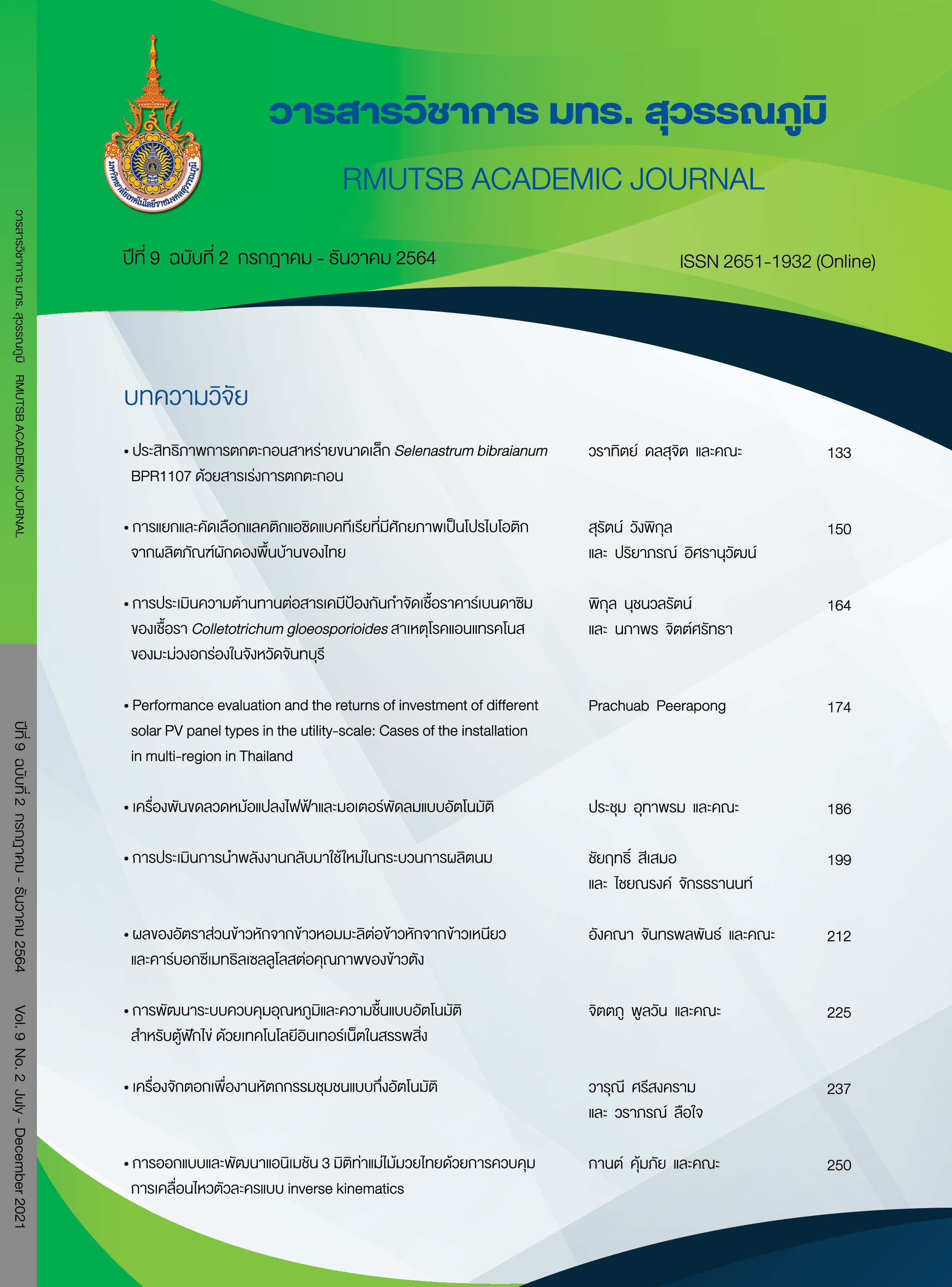การประเมินความต้านทานต่อสารเคมีป้องกันกำจัดเชื้อราคาร์เบนดาซิมของเชื้อรา Colletotrichum gloeosporioides สาเหตุโรคแอนแทรคโนสของมะม่วงอกร่อง ในจังหวัดจันทบุรี
Main Article Content
บทคัดย่อ
การแยกเชื้อรา Colletotrichum gloeosporioides สาเหตุโรคแอนแทรคโนสของมะม่วงพันธุ์อกร่องจากจังหวัดจันทบุรี ด้วยวิธีการ tissue transplanting สามารถแยกเชื้อราสาเหตุโรคได้ทั้งหมด 27 ไอโซเลต เมื่อทำการประเมินความต้านทานต่อสารเคมีป้องกันกำจัดเชื้อราคาร์เบนดาซิม โดยเลี้ยงเชื้อราทุกไอโซเลตบนอาหาร potato dextrose agar (PDA) ที่ผสมสารคาร์เบนดาซิมที่ระดับความเข้มข้น 0.1, 1, 10, 100, 500 และ 1,000 ppm ผลการประเมินระดับความต้านทานของเชื้อราต่อสารคาร์เบนดาซิม พบว่าเชื้อรา C. gloeosporioides จำนวน 14 ไอโซเลต (51.85 เปอร์เซ็นต์) มีความต้านทานต่อสารคาร์เบนดาซิมระดับสูง (highly resistance: HR) และมีจำนวน 13 ไอโซเลต (48.15 เปอร์เซ็นต์) ที่อ่อนแอต่อสารคาร์เบนดาซิม (sensitive: S) ไม่พบไอโซเลตที่มีระดับความต้านทานต่อสารคาร์เบนดาซิมระดับปานกลาง (moderate resistance: MR) และระดับความต้านทานต่ำ (weakly resistance: WR) ผลการทดสอบประสิทธิภาพสารเคมีป้องกันกำจัดเชื้อราจำนวน 9 ชนิด ในอัตราแนะนำข้างฉลาก ในการยับยั้งการเจริญของเส้นใยเชื้อราที่ต้านทานต่อสารคาร์เบนดาซิมระดับสูงด้วยวิธี poisoned food technique พบว่าแมนโคเซบ แคปแทน โพรคลอราช ไดฟีโคนาโซล+อะซ็อกซี่สโตรบิน และไดฟีโคนาโซล+โพรพิโคนาโซล มีเปอร์เซ็นต์ยับยั้งการเจริญของเส้นใยเท่ากับ 100 เปอร์เซ็นต์ รองลงมาคือ คาร์บอกซิน เบนโนมิล คาร์เบนดาซิม และคอปเปอร์ไฮดรอกไซด์ มีเปอร์เซ็นต์ยับยั้งการเจริญของเส้นใยเท่ากับ 87.78, 72.22, 64.89 และ 22.89 เปอร์เซ็นต์ ตามลำดับ การศึกษาครั้งนี้ให้ข้อมูลเบื้องต้นเกี่ยวกับชนิดของสารเคมีป้องกันกำจัดเชื้อราที่เหมาะสมในการจัดการโรคแอนแทรคโนสของมะม่วงอกร่องในจังหวัดจันทบุรี
Article Details
ต้นฉบับที่ได้รับการตีพิมพ์ถือเป็นสิทธิของเจ้าของต้นฉบับและของวารสารวิชาการ มทร.สุวรรณภูมิ เนื้อหาบทความในวารสารเป็นแนวคิดของผู้แต่ง มิใช่เป็นความคิดเห็นของคณะกรรมการการจัดทำวารสาร และมิใช่ความรับผิดชอบของมหาวิทยาลัยเทคโนโลยีราชมงคลสุวรรณภูมิ
เอกสารอ้างอิง
Bincader, S., Pongpisutta, R., & Rattanakreetakul, C. (2018). Responsiveness of Colletotrichum gloeosporioides (Penz.) Sacc causing anthracnose disease of mango cv. Nam Dork Mai See Tong to fungicides. Agricultural Science Journal, 49(4)(Suppl.), 167-170. (in Thai)
Chaichana, S. (2010). Characterization of Colletotrichum spp. resistant to a fungicide carbendazim in fruit. (Master’s thesis). Chiang Mai University, Chiang Mai. (in Thai)
Chaichana, S., & Nalumpang, S. (2007). Detection of fungicide carbendazim resistance in Colletotrichum spp. Causing anthracnose disease from mango fruits. Agricultural Science Journal, 38(5), 205-208. (in Thai)
Dhingra, O. B., & Sinclair, J. B. (1995). Basic plant pathology methods (2nd ed.). Boca Raton: CRC Press.
Information Technology and Communication Center, Department of Agricultural Extension. (2016). Agricultural production information system: Aok Rong. Retrieved 21 January 2020, from http://www.agriinfo.doae.go.th/year59/plant/rortor/plant/rortor/fruit2/mango8.pdf (in Thai)
Kongtragoul, P., & Nalumpang, S. (2010). Characterization of Colletotrichum gloeosporioides resistant to carbendazim. Journal of Agriculture, 26(3), 203-212. (in Thai)
Kongtragoul, P., Nalumpang, S., Miyamoto, Y., Izumi, Y., & Akimitsu, K. (2011). Mutation at codon 198 of TUB2 gene for carbendazim resistance in Colletotrichum gloeosporioides causing mango anthracnose in Thailand. Journal of Plant Protection Research, 51(4), 378-384.
Kumar, A. S., Reddy, N. P. E., Reddy, K. H., & Devi, M. C. (2007). Evaluation of fungicidal resistance among Colletotrichum gloeosporioides isolates causing mango anthracnose in agri export zone of Andhra Pradesh, India. Plant Pathology Bulletin, 16, 157-160.
Likitmanchai, V., Thepchuasook, T., & Lertsuchatavanich, U. (2019). Efficacy of fungicides to control Colletotrichum gloeosporioides causal agent of mango anthracnose disease. The 14th National Plant Protection Conference: Precision agriculture approaches to Thai farming (pp. 716-721). Cha Am: Thai Crop Protection Association. (in Thai)
Ma, Z., & Michailides, T. J. (2005). Advances in understanding molecular mechanisms of fungicide resistance and molecular detection of resistant genotypes in phytopathogenic fungi. Crop Protection, 24(10), 853-863.
Nalumpang, S., Miyamoto, Y., Miyake, C., Izumi, Y., Akitmitsu, K., & Kongtragoul, P. (2010). Point mutations in the beta-tubulin gene conferred carbendazim-resistant phenotypes of Colletotrichum gloeosporioides causing Nam Dok Mai mango anthracnose. Journal of Agricultural Technology, 6(2), 365-378.
Peres, N. A. R., Souza, N. L., Peever, T. L., & Timmer, L. W. (2004). Benomyl sensitivity of isolates of Colletotrichum acutatum and C. gloeosporioides from citrus. Plant Disease, 88(2), 125-130.


